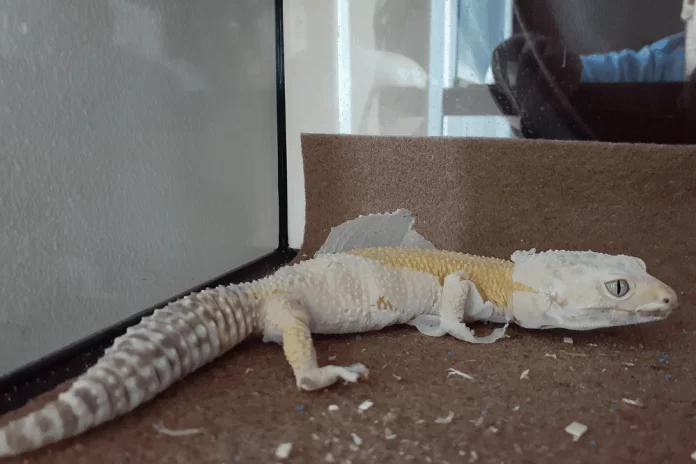Last Updated on November 2, 2023 by Fumipets
Unlocking the Mysteries of Leopard Gecko Shedding: A Guide for Reptile Enthusiasts
Leopard gecko shedding is a natural and essential process that these reptiles go through to accommodate their growth. Unlike some other reptiles, leopard geckos shed their skin in sections rather than all at once. Shedding helps them remove old, dead skin, allowing for healthier and more vibrant skin underneath. As a leopard gecko owner, understanding the shedding process is crucial to ensure your pet’s well-being and comfort.
Leopard Gecko Shedding
Leopard geckos are nocturnal, gentle, ground-dwelling geckos that are regarded as simple to tame. Due to their low maintenance needs and fascinating nature, they may make excellent pets. Leopard geckos are intriguing-looking reptiles that shed often. They are yellow, white, and have black patches.
Even while it is a fascinating trait, shedding time may also end up being one of the most stressful situations for gecko owners if things do not go as planned. The information about gecko shedding patterns, what you can do to assist, and other shedding-related queries is provided here.
How Often Should A Leopard Gecko Shed?
The leopard gecko is a little lizard that is always developing, and when it outgrows its skin, it will shed it and grow new skin that fits it better. While most sheds go smoothly and cause your gecko little physical or psychological discomfort, issues may arise and are more frequent in reptiles with other and pre-existing ailments and illnesses.
The length of time between shed cycles varies depending on the gecko’s age and physical health. Its fertility status is also important. Your gecko will typically shed every four to eight weeks. Because they develop considerably more quickly than adults, young leopards lose their skin every week or two. Adults shed once every two months or so.
How Long Does It Take For A Leopard Gecko To Finish Shedding?
No matter whether you have a baby or adult gecko, the whole shedding process ought to be finished in 24 to 48 hours. It should have lost its old skin by now, and it could even consume the shed.
Should I Feed My Leopard Gecko While It’s Shedding?
Geckos normally feed every two to four days, and they may be ready to lose their skin. As a result, they often do not need to eat when shedding, and it is typical for the species to consume less or not at all while shedding. Remove any food that remains in his enclosure. Live food might hurt your leopard’s delicate skin, while other food can spoil, begin to smell or become stressful.
Should I Handle My Leopard Gecko When Shedding?
A gecko’s skin may become very sensitive when it is shedding, which might make it agitated and moody. Even the calmest geckos may get a bit hostile while they are shedding, only because it could hurt to touch them.
They will at the very least be itchy, and shedding animals often want to be left alone. Give your leopard gecko some room before and just after the shedding process for a few days. Within two to three days after the shedding is finished, they ought to be back to normal.

Can Leopard Geckos Die From Shedding?
A healthy leopard gecko shouldn’t have any negative impacts from shedding, although issues with shedding might arise often if your setup is subpar. One of the most frequent reasons for shedding issues is a lack of humidity and moisture, and these issues might involve the skin being snagged in a specific location as the body below develops.
The toes are one of the most typical places for this to occur. A toe may potentially come off if the skin is kept on for too long and causes circulation issues. This therefore causes difficulty with climbing and other things. Another problematic location is the skin around the face, which may cause issues with hydration and nutrition.
After two to three days, if the skin hasn’t entirely shed, you may need help.
Pulling the skin might harm it permanently, so avoid doing it. He should be given a bath with half an inch of warm water, then left for approximately a minute. This may aid in skin removal from the feet and tummy.
Use moist towels in a heated container to produce a humid atmosphere like in a sauna. Make sure the container is aired before locking your gecko inside for roughly 30 minutes. To remove extra skin, very carefully massage it off with a damp cotton ball.
Why Is My Leopard Gecko Constantly Shedding?
When your gecko is really following a normal shedding cycle, it may seem like it is continually shedding since geckos may shed every four weeks, even as adults, and the whole process only takes a few days.
Keep tabs on how often your leopard sheds; even if it happens just every few weeks, this may be normal if yours is developing fast, which may happen if he is consuming more than usual.
Tips To Help A Leopard Gecko Shed
If you make sure that a leopard gecko’s cage and setup are adequate, it should typically shed completely well on its own and without any help. Make sure your gecko is well hydrated and that the humidity and moisture levels in its cage are appropriate.
Make sure the hide on your gecko is wet. This will provide your gecko warmth, and the wetness will also give it the humidity it requires. When it is time for shedding, misting the terrarium may also aid to raise the humidity, which then functions similarly to steaming wallpaper for simpler removal.
Additionally, make sure your pet lizard has access to a rough surface that it may brush against to assist shed skin. This would probably be a rock in the wild, therefore if your terrarium’s surfaces are all too smooth, he may not be able to shed correctly.

Conclusion
Leopard geckos naturally lose their skin when they grow too large for it. Even though it often happens without incident, your terrarium has to be correctly set up to avoid problems with this monthly occurrence. Make sure there is enough moisture and humidity, and provide something to rub against.
If everything else fails, think about giving your gecko a bath or even taking him into a sauna to promote optimal shedding conditions. Also, it’s okay if your leopard consumes the skin that has shed. Although a bit nasty, this is quite normal.
5 FAQs About Leopard Gecko Shedding:
Why do leopard geckos shed their skin?
Leopard geckos shed their skin to accommodate their growth. Shedding helps them remove old, dead skin and replace it with a healthier layer.
How often do leopard geckos shed?
The frequency of shedding varies with age. Young leopard geckos shed more often as they grow rapidly, while adults shed less frequently, typically every 4-8 weeks.
What are the signs that a leopard gecko is about to shed?
Common signs include increased hiding, dull or opaque skin, loss of appetite, and increased licking or scratching at their skin.
How can I assist my leopard gecko during shedding?
Ensure your gecko has a humid hide within its enclosure to aid in the shedding process. Mist the enclosure regularly to maintain humidity. Avoid handling during shedding, as the skin is delicate and can tear.
Is it normal for leopard geckos to eat their shed skin?
Yes, it’s common for leopard geckos to consume their shed skin. This behavior is a natural instinct and provides them with essential nutrients. However, ensure they have a healthy diet to meet their nutritional needs.


















